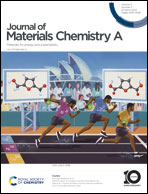Enhanced dielectric energy storage in multilayer films via valley-type structural design†
Abstract
Dielectric capacitors with high energy storage performance are highly needed parts in modern electronic devices. In this work, we realized high energy storage performance by regulating the electron transport based on the barrier height in the sandwich structures of Ba(Hf0.17Ti0.83)O3 (BHT) and 0.85BaTiO3–0.15Bi(Mg0.5Zr0.5)O3 (BT–BMZ). It was found that the breakdown strength of a valley-type structure (BT–BMZ/BHT/BT–BMZ) film is higher than that of a peak-type structure (BHT/BT–BMZ/BHT) film. The engineered valley-type structure dielectric capacitor exhibits not only a high energy density of 127.80 J cm−3 with an efficiency of 70.80% at room temperature but also an ultra-high energy density of 87.22 J cm−3 at 200 °C. This giant energy density at 200 °C is much higher than that of most of the reported dielectric capacitors. The high performance of the valley-type structure is understood as a function of the “Valley” (lower barrier height), which can trap electrons and prevent them from hopping from the top electrode to the bottom electrode. Moreover, the weak polar BHT and formed weakly inter-coupled nanodomains in the interface region are beneficial for forming slimmer P–E loops and reducing the polarization switching loss in the valley-type structure. Our results indicate that the electron transport regulation opens up a new way to enhance the breakdown strength and energy density of dielectric capacitors.



 Please wait while we load your content...
Please wait while we load your content...